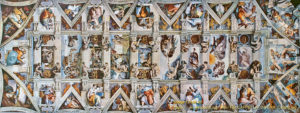Sistine Chapel Ceiling
Sistine Chapel Ceiling
The Sistine Chapel ceiling was painted between 1508 and 1512. The ceiling is a flattened barrel vault supported on twelve triangular pendentives that rise from between the windows of the chapel. The commission, as envisaged by Pope Julius II, was to adorn the pendentives with figures of the twelve apostles. Michelangelo, who was reluctant to take the job, persuaded the Pope to give him a free hand in the composition. The resultant scheme of decoration awed his contemporaries and has inspired other artists ever since. The scheme is of nine panels illustrating episodes from the Book of Genesis, set in an architectonic frame. On the pendentives, Michelangelo replaced the proposed Apostles with Prophets and Sibyls who heralded the coming of the Messiah.
The Sistine Chapel Ceiling (1508–12)
Michelangelo began painting with the later episodes in the narrative, the pictures including locational details and groups of figures, the Drunkenness of Noah being the first of this group. In the later compositions, painted after the initial scaffolding had been removed, Michelangelo made the figures larger. One of the central images, The Creation of Adam is one of the best known and most reproduced works in the history of art. The final panel, showing the Separation of Light from Darkness is the broadest in style and was painted in a single day. As the model for the Creator, Michelangelo has depicted himself in the action of painting the ceiling.
As supporters to the smaller scenes, Michelangelo painted twenty youths who have variously been interpreted as angels, as muses, or simply as decoration. Michelangelo referred to them as “ignudi”. The figure reproduced may be seen in context in the above image of the Separation of Light from Darkness. In the process of painting the ceiling, Michelangelo made studies for different figures, of which some, such as that for The Libyan Sibyl have survived, demonstrating the care taken by Michelangelo in details such as the hands and feet. The Prophet Jeremiah, contemplating the downfall of Jerusalem, is an image of the artist himself.

